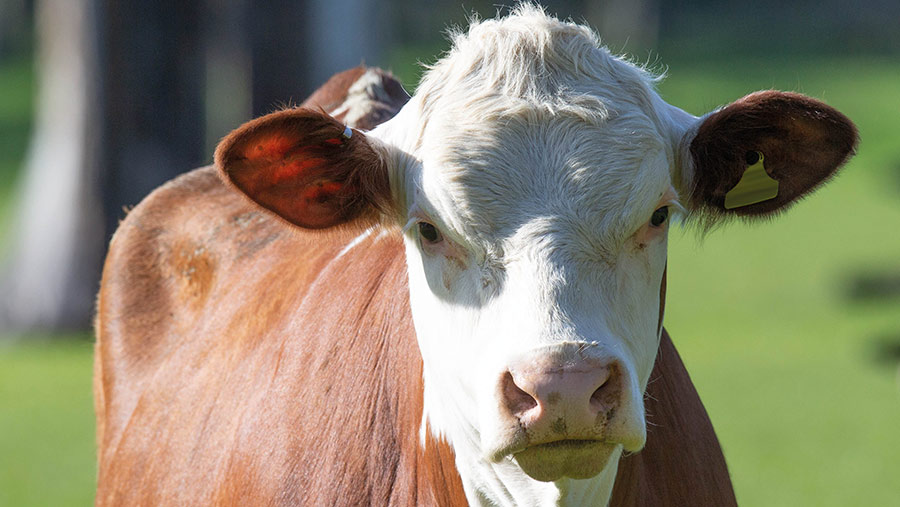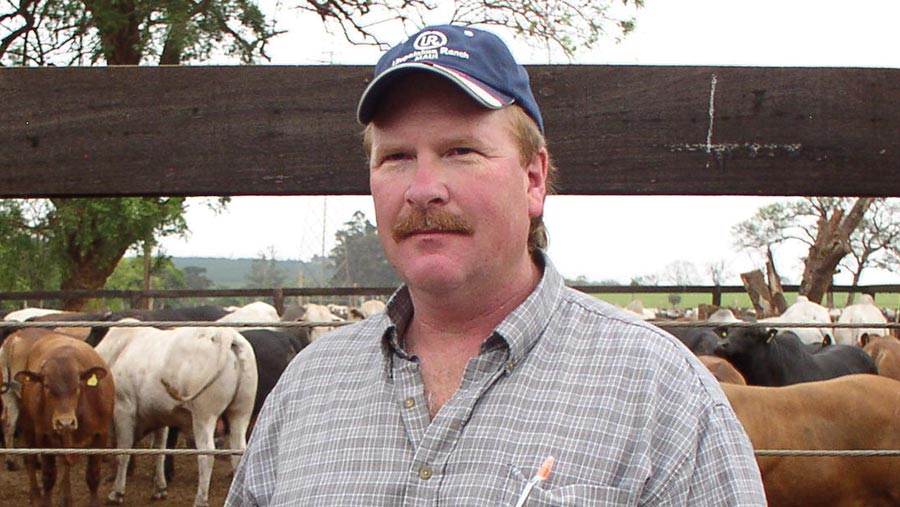How to ensure heifers calve at two years old
 © Tim Scrivener
© Tim Scrivener For suckler cows to be most profitable, calving for the first time at 24 months old is considered optimum.
Research suggests that calving heifers for the first time at this age is pivotal for reducing the cost of production and increasing lifetime reproductive performance.
However, it is estimated that only 35% of English suckler herds meet this target.
Nebraska is one of the biggest red meat-producing states in the US and, as such, is known for its research into beef systems – with much of this carried out at the West Central Research and Extension Centre at the University of Nebraska-Lincoln.
See also:What is pelvic scoring and how valuable is it for calving?
Dr Rick Funston, professor of animal science at the University of Nebraska-Lincoln, details some of the key learnings from beef production in the US state that could help UK beef breeders hit target age.
Replacement selection
The starting point for getting a cow to calve at 24 months is having the right cow in the herd to start with, and this is based on the previous generation.
First, breeders should decide on an appropriate replacement rate – in Nebraska, this averages 16% – and thinking about whether it is better to buy in or breed replacements.
In 2005, fellow researcher Jim Gosey formulated a replacement heifer selection criterion based on the following factors:
- Cull daughters of “bad mark” cows (cows that need assistance at calving, calve late (+42 days), fail to wean a calf or have big teats, wean a light calf, have a bad temperament, and need help feeding their offspring)
- Cull lightweights, big birthweights, and big-framed animals
- Cull the youngest (heifers born +45 days in the calving season)
- Select daughters of oldest cows – that might be counterintuitive to “genetic improvement”, but Mr Gosey claimed older cows had likely been doing well on farm for a long time, so selecting replacements based on these animals could help produce more favourable replacements
- Select for form – depth of rib, chest width and guts to enable the animal to eat poor-quality feed
While maternal traits are fundamental, sire selection can actually be more important in a commercial scenario, with research demonstrating that it determines more than 85% of the total improvement made in a herd.
One of the key indicators of a more productive animal is when it is born. Studies have shown the time of calving affects heifer progeny – and subsequently, that ability to calve at 24 months.
UK producer advice
For UK producers, AHDB has recently issued new advice in its online guide, Breeding, selecting and managing beef replacement heifers (PDF), co-written by knowledge exchange programme manager Sarah Pick, who spent time in Nebraska as part of her Nuffield Scholarship.
Heifers born in the first cycle (first period of calving, based on 21 days) were heavier pre-breeding, cycled more frequently, had higher pregnancy rates, and were more likely to calve within the first 21 days.
At calving, these heifers also had a heavier calf and got back in-calf again sooner.
Out of everything we can select for – if we know nothing else about an animal – age is very important when trying to ensure animals calve down at 24 months.
Breeding protocols
To get calves to be born earlier, synchronisation protocols are often used in Nebraska, where a seven-day Co-Synch + CIDR is the most preferred protocol.
Another protocol recommended by Dr Funston is the synchronisation of oestrus in cyclic cows/heifers.
“Sometimes we only associate synchronisation with artificial insemination (AI), but I believe that half of the benefit of an AI programme is that the cows are synchronised, so why not do this with natural service?” he says.
It is a simple protocol that involves turning the bulls in and then five days later giving prostaglandin (PGF).

Rick Funston on the ranch © Rick Funston
Dr Funston has been adopting this approach on a ranch running a 45-day breeding season for a number of years now. Its pregnancy rate is currently 90%-plus.
Data from Bob Cushman at the US Animal Meat Research centre proved this theory in a 2013 study.
It showed that if a heifer got pregnant for the first time in 21 days, she had greater longevity and produced calves with heavier weaning weights, meaning that by the time this animal had weaned her sixth calf, she had weaned another calf weight equivalent.
Breeding target weight
Older data suggests that cows which did not weigh in at 65% of their mature weight at breeding would be more likely to have issues due to dystocia, increased mortality, and lower pregnancy rates.
However, this was challenged in a study that saw no tangible difference in pregnancy when cows were at 53% of their mature weight at breeding (compared with 58%).
Furthermore, there was also no difference in post-weaning growth.
While regular weighing isn’t common practice in the US in the same way as it is in the UK, where it is done, it tends to be at key timings including pre-calving, pre-breeding and at weaning.
The optimum target should be to calve at about 85% of mature weight.
Nutrition
Nutrition is an area where UK and US suckler systems vary greatly.
However, good nutrition is fundamental for ensuring heifers deliver their first calf at 24 months.
With recent periods of more than 40cm of snow, teamed with droughts in the spring, access to quality forage in Nebraska is limited, meaning body condition score has to be carefully managed to ensure timely calving.
To do this, Dr Funston says it is really important for all farmers to have feedstuffs analysed.
“Balanced diets are key. Post-calving, most diets will no doubt involve grazing.
“While grass will usually meet nutritional requirements, stress situations such as droughts can affect this, so be mindful [of this].
“It is also important to not have animals gaining more before breeding than they do after.
“Quite often heifers get over-fat pre-breeding but go into a grazing environment where those pre-breeding gains cannot be sustained.
“If they are declining in gain, even though you might not see it, older data says this can cause more embryonic loss.”
Dr Rick Funston was speaking at an AHDB webinar.
